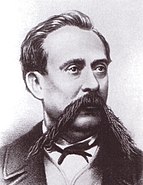| Nikolay Nikolaevich Zinin | |
|---|---|
 Nikolay Zinin Nikolay Zinin | |
| Born | (1812-08-25)25 August 1812 Shusha, Elizavetpol Governorate, Russian Empire |
| Died | 18 February 1880(1880-02-18) (aged 67) Saint Petersburg, Russian Empire |
| Nationality | Russian |
| Alma mater | University of Kazan |
| Scientific career | |
| Institutions | University of Kazan University of Saint Petersburg |
| Doctoral advisor | Justus Liebig |
| Doctoral students | Alexander Borodin Aleksandr Butlerov |
Nikolay Nikolaevich Zinin (Russian: Никола́й Никола́евич Зи́нин; 25 August 1812 – 18 February 1880) was a Russian organic chemist.
Life
Zinin was born in Shusha where his father served as diplomatic employee. Nicolay became orphan after cholera pandemic when his parents and sister died. He studied at the University of Kazan where he graduated in mathematics but he started teaching chemistry in 1835. To improve his skills he was asked to study in Europe for some time, which he did between 1838 and 1841. He studied with Justus Liebig in Giessen, where he finished his research on the benzoin condensation, which was discovered by Liebig several years before. He presented his research results at the University of Saint Petersburg, where he received his Ph.D. He became Professor for Chemistry in the same year at the University of Kazan and left for the University of Saint Petersburg in 1847 where he also became a member of the St. Petersburg Academy of Sciences and first president of the Russian Physical and Chemical Society (1868–1877).
In St. Petersburg, professor Zinin was a private teacher of chemistry to the young Alfred Nobel.
Work
He is known for the so-called Zinin reaction or Zinin reduction, in which nitro aromates like nitrobenzene are converted to amines by reduction with ammonium sulfides. In 1842 Zinin played an important role in identifying aniline.
References
- Zinin, N. (1839). "Beiträge zur Kenntniss einiger Verbindungen aus der Benzoylreihe" [Contributions to the knowledge of some compounds from the benzoyl series]. Annalen der Pharmacie (in German). 31 (3): 329–332. doi:10.1002/jlac.18390310312.
- Zinin, N. (1840). "Ueber einige Zersetzungsprodukte des Bittermandelöls" [On some decomposition products of bitter almond oil]. Annalen der Pharmacie (in German). 34 (2): 186–192. doi:10.1002/jlac.18400340205.
- Vinogradov, S. N. (1965). "Chemistry at Kazan University in the Nineteenth Century: A Case History of Intellectual Lineage". Isis. 56 (2): 168–173. doi:10.1086/349954. JSTOR 227912. S2CID 144243766.
- Porter, H. K. (1973). "The Zinin Reduction of Nitroarenes". Org. React. 20 (4): 455–481. doi:10.1002/0471264180.or020.04. ISBN 0471264180.
- Zinin, N. (1842). "Beschreibung einiger neuer organischer Basen, dargestellt durch die Einwirkung des Schwefelwasserstoffes auf Verbindungen der Kohlenwasserstoffe mit Untersalpetersäure" [Description of some new organic bases, represented by the action of hydrogen sulphide on hydrocarbons with sub-nitric acid]. Journal für Praktische Chemie (in German). 27 (1): 140–153. doi:10.1002/prac.18420270125.
- Willstatter, Richard; Kubli, Heinrich (1908). "Über die Reduktion von Nitroverbindungen nach der Methode von Zinin" [On the reduction of nitro compounds by the method of Zinin]. Berichte der deutschen chemischen Gesellschaft (in German). 41 (2): 1936–1940. doi:10.1002/cber.19080410273.
External links
This article about a Russian chemist is a stub. You can help Misplaced Pages by expanding it. |